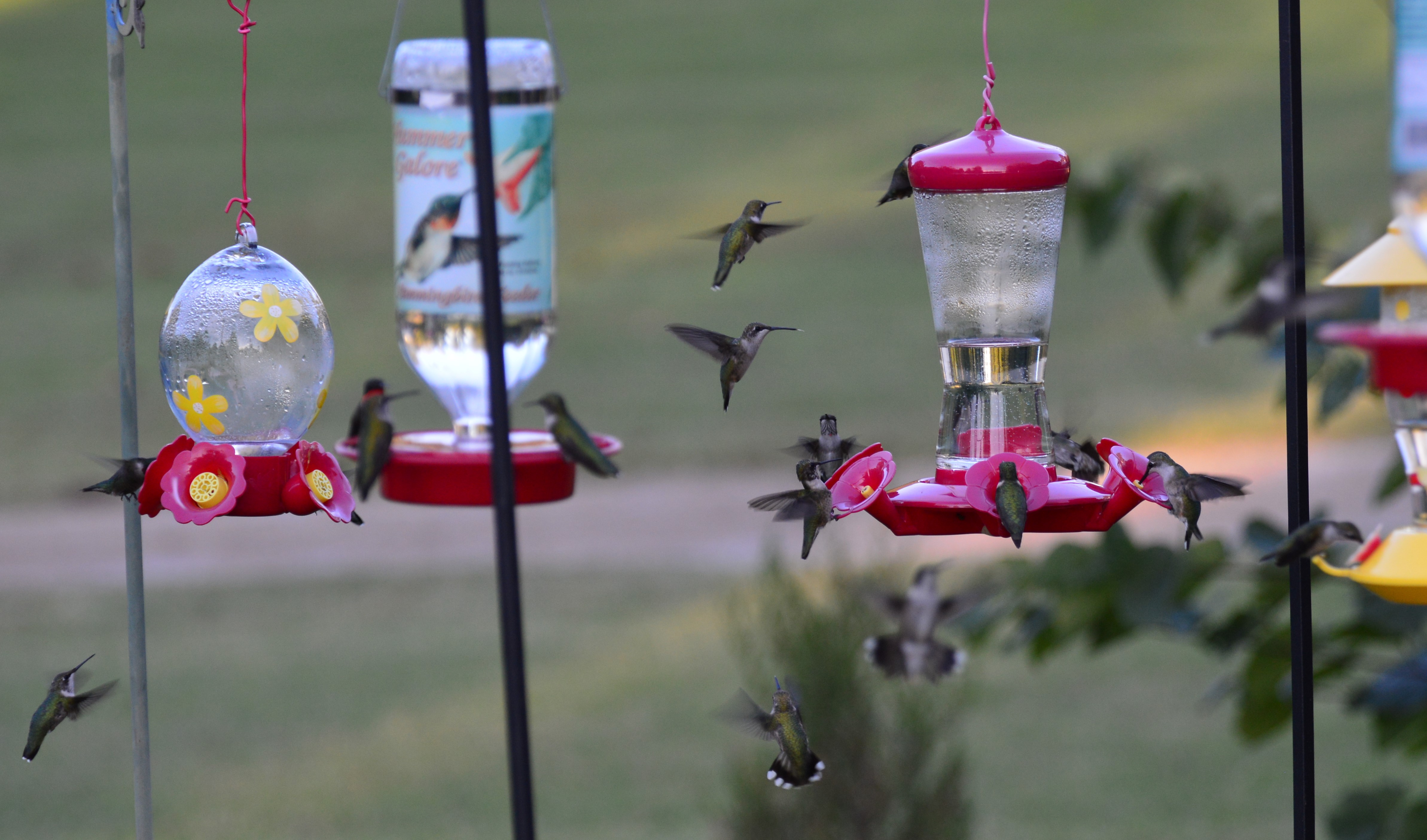Attract Hummingbirds to your yard!
There are over 330 different hummingbird species (all of them found only in the Western Hemisphere) and the Ruby-throated Hummingbird is the only one found regularly in our area. Each year, these little birds migrate around 2,000 miles each way between here and their wintering grounds in Central America—an amazing feat for a bird that weighs only about as much as a penny!
Ruby-throated Hummingbirds get their name from the brilliant red throat that male birds display. Surprisingly, those feathers do not contain any red pigment and the throat color can change depending on how the light hits it.
Females are larger than males and have white throats and duller overall coloring, which helps them to stay hidden when sitting on their nests. Those nests are about the size of a quarter and made with lichens, mosses, and other small plant fibers, all “stitched” together with spider web.
The spider web acts like elastic, allowing the nest to expand as the chicks get larger. The female lays 1-3 eggs (each smaller than a pea) and does all of the incubation and parenting by herself. The total time from when the egg is first laid until the young bird leaves the nest is about 5 weeks.
Hummingbirds are fascinating to watch and are quite bold around people. The best way to get them to your yard is by putting out a hummingbird feeder. One of the primary sources of food for hummingbirds is nectar, and sugar water is an easy substitute for your feeder. You can purchase specialty mixes, but most people make their own at home using a 4:1 water to white sugar mix (see Nectar-making tips).
Hummingbird feeding basics:
- There are many types of hummingbird feeders, but they fall into two general categories – saucer and bottle. The saucer-type allows for better viewing and are easier to clean. The bottle-type are usually fancier and often hold more liquid. Hummingbirds like them both!
- Place the feeder where it will be easy for you to watch and easy for you to reach. As long as the birds can fly to it, they will find it.
- Try to avoid placing it in a location that gets all-day direct sunlight. That can cause the sugar water to spoil more quickly. If it is in prolonged direct light, change the sugar water every 1-2 days.
- Clean your feeder at least weekly. A diluted bleach soak (10:1 water to bleach ratio) for 30 minutes works well. Make sure to rinse thoroughly!
- Most saucer type-feeders have a well in their center that you can fill up with water. This creates a moat to keep ants and other crawling insects out of the feeder.
- Hummingbirds are highly territorial and—ounce for ounce—some of the most aggressive birds out there. Don’t be surprised if you see only one bird at a time at your feeder or see one chasing other birds away from the feeder. Also, don’t be alarmed if the birds seem to disappear for a while in early summer. There are lots of native plants in bloom at that time and they may be filling up on them. They will return in late summer when many plants quit producing nectar.
- There’s a chance you may see other birds at your hummingbird feeder. Woodpeckers, orioles, and chickadees are all known to stop by for a quick sip, as will moths and butterflies. Racoons and flying squirrels are also known to stop by for a “nightcap”.
- Sit back and enjoy the show.
Nectar-making Tips
- Use only white cane sugar. Do not use brown sugar or honey – they contain ingredients or compounds that hummingbirds cannot digest.
- Mix 1 part sugar with 4 parts water. If putting the entire amount out immediately , just stir until the sugar granules dissolve and fill the feeder. If making a larger batch that you will use over a week or more, boil the mixture to make sure it is fully dissolved, then store it in the refrigerator until you use it.
- Do not add red food coloring to the mix. Red food coloring may contain ingredients that are harmful to hummingbirds. Although Ruby-throated Hummingbirds are attracted to red colored things, the feeder usually has some red on it.
- Make sure the sugar water has warmed up (if taking it from the fridge) or cooled down (if it was just boiled). The temperature of the sugar water should be the same as the nectar would be from inside a flower.
- Consider making up a simple syrup mixture, which is a one-to-one ratio of sugar and water. Boil it at a rolling boil for several minutes, then once cool, store it in a closed jar in the refrigerator. When you are ready to fill your feeders, add three parts water to one part simple syrup, stir, and serve. One batch of this concentrated mixture should last you several weeks. In addition to saving you time making nectar, you will always have some simple syrup in your fridge if you want to make homemade lemonade or a mojito to enjoy while you watch the hummingbirds at your feeder!
Photo: James Baker/Audubon Photography Awards
